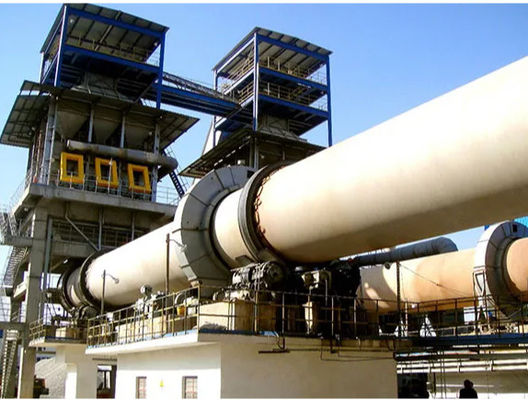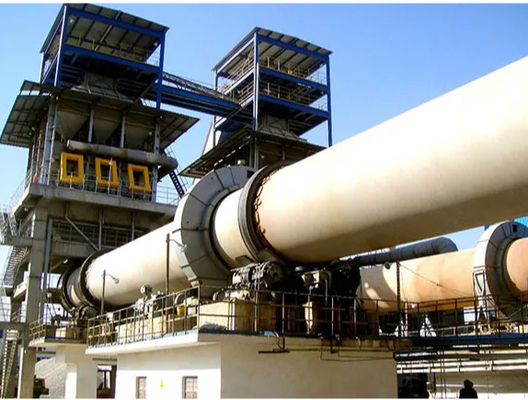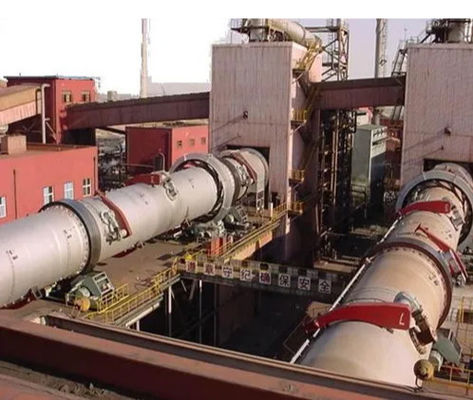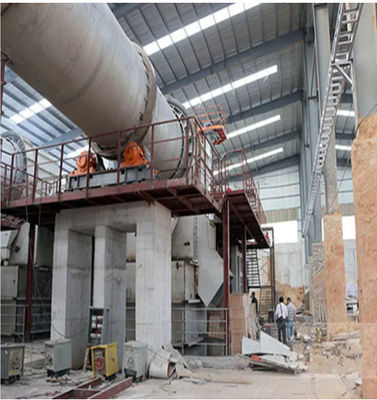1. Cement Rotary Kiln Introductionet and Dry Cement Rotary Kiln
Rotary kiln is rotary forging kiln for short, which is one of building material equipment. It is divided into cement kiln, metallurgy and chemical kiln and lime kiln as per the different material treatment. Cement kiln is applied to carline cement clinker, which has two types,dry-type cement production kiln and wet-type cement production kiln. Metallurgy and chemical kiln is mainly used to magnetizing roast lean iron ore, oxidation roast the nickel chromium iron ore in the steel and iron plant. It is also used to roast bauxite chamotte in the refactory plant and chamotte, aluminium hydroxide in alumimium plant,crome ore in the Chemical plant. Lime kiln is use to roast active lime and soft-burned dolomite in steel plant and iron alloy plant.The cement kiln burns rawmix to produce clinker, which is then ground to make cement.
The cement kiln is the heart of the cement making process: this is today almost a cliché, but was not always quite so true. In the modern cement plant, the kiln is the most expensive and technically complex part of the plant, and because it must be run all the time (unlike other sections of the plant) it effectively defines the output capacity of the plant. It stands out also in that, unlike the other processes involved, the “pyroprocessing” stage of cement manufacture is absolutely unique to the industry, and has devoted to it a complex and specialized multi-disciplinary technology all its own.
Because of this, the cement kiln scarcely needs to be considered under the general category of “kilns”. In addition to its uniqueness, it also stands out among pyroprocessing equipment as by far the most economically significant world-wide. The blast furnace for iron production produces less than half the tonnage produced by cement kilns, although it runs ahead in terms of fuel usage. In terms of CO2 production, Portland cement kilns – when using limestone as a raw material – are by far the largest industrial manufacturing source. The taming of these emissions is likely to further increase the sophistication of the kiln design.
2.Cement rotary kiln technical characteristics:
- Kiln body is made of high quality composed of carbon steel or alloy steel plate and automatic welding;
- Tyre,Support Roller,Open gear adopts alloy cast steel;
- Sliding bearing with large gap not scraping tile bearing;
- Transmission device adopts hard tooth surface reducer, flexible diaphragm coupling, dc motor;
- Adopts hydraulic gear wheel;
- Preheater scales were used respectively to veiw of kiln head, and cylinder pressure tight seal;
- A slow drive device.
3.Cement Rotary Kiln Wet and Dry Cement Rotary Kiln
4.Cement Rotary Kiln Specification Wet and Dry Cement Rotary Kiln
| Product specifications(m) |
Kiln dimensions |
Capacity(t/d) |
Rotation speed(r/min) |
Motor power(kw) |
Total weight(t) |
| Diameter(m) |
Length(m) |
Obliquity(%) |
| Φ2.5×40 |
2.5 |
40 |
3.5 |
180 |
0.44-2.44 |
55 |
149.61 |
| Φ2.5×50 |
2.5 |
50 |
3 |
200 |
0.62-1.86 |
55 |
187.37 |
| Φ2.5×54 |
2.5 |
54 |
3.5 |
204 |
0.48-1.45 |
55 |
196.29 |
| Φ2.7×42 |
2.7 |
42 |
3.5 |
320 |
0.10-1.52 |
55 |
198.5 |
| Φ2.8×44 |
2.8 |
44 |
3.5 |
400 |
0.437-2.18 |
55 |
201.58 |
| Φ3.0×45 |
3 |
45 |
3.5 |
500 |
0.5-2.47 |
75 |
210.94 |
| Φ3.0×48 |
3 |
48 |
3.5 |
700 |
0.6-3.48 |
100 |
237 |
| Φ3.0×60 |
3 |
60 |
3.5 |
800 |
0.3-2 |
100 |
310 |
| Φ3.2×50 |
3.2 |
50 |
4 |
1000 |
0.6-3 |
125 |
278 |
| Φ3.3×52 |
3.3 |
52 |
3.5 |
1300 |
0.266-2.66 |
125 |
283 |
| Φ3.5×54 |
3.5 |
54 |
3.5 |
1500 |
0.55-3.4 |
220 |
363 |
| Φ3.6×70 |
3.6 |
70 |
3.5 |
1800 |
0.25-1.25 |
125 |
419 |
| Φ4.0×56 |
4 |
56 |
4 |
2300 |
0.41-4.07 |
315 |
456 |
| Φ4.0×60 |
4 |
60 |
3.5 |
2500 |
0.396-3.96 |
315 |
510 |
| Φ4.2×60 |
4.2 |
60 |
4 |
2750 |
0.4-3.98 |
375 |
633 |
| Φ4.3×60 |
4.3 |
60 |
3.5 |
3200 |
0.396-3.96 |
375 |
583 |
| Φ4.5×66 |
4.5 |
66 |
3.5 |
4000 |
0.41-4.1 |
560 |
710.4 |
| Φ4.7×74 |
4.7 |
74 |
4 |
4500 |
0.35-4 |
630 |
849 |
| Φ4.8×74 |
4.8 |
74 |
4 |
5000 |
0.396-3.96 |
630 |
899 |
| Φ5.0×74 |
5 |
74 |
4 |
6000 |
0.35-4 |
710 |
944 |
| Φ5.6×87 |
5.6 |
87 |
4 |
8000 |
Max4.23 |
800 |
1265 |
| Φ6.0×95 |
6 |
95 |
4 |
10000 |
Max5 |
950×2 |
1659 |
5.Wet process cement rotary kilns Wet and Dry Cement Rotary Kiln
The original rotary cement kilns were called 'wet process' kilns. In their basic form they were relatively simple compared with modern developments. The raw meal was supplied at ambient temperature in the form of a slurry.
A wet process kiln may be up to 200m long and 6m in diameter. It has to be long because a lot of water has to be evaporated and the process of heat transfer is not very efficient.
The slurry may contain about 40% water. This takes a lot of energy to evaporate and various developments of the wet process were aimed at reducing the water content of the raw meal. An example of this is the 'filter press' (imagine a musical accordion 10-20 metres long and several metres across) - such adaptions were described as 'semi-wet' processes.
The wet process has survived for over a century because many raw materials are suited to blending as a slurry. Also, for many years, it was technically difficult to get dry powders to blend adequately.
6.Dry process cement rotary kilns Wet and Dry Cement Rotary Kiln
In a modern works, the blended raw material enters the kiln via the pre-heater tower. Here, hot gases from the kiln, and probably the cooled clinker at the far end of the kiln, are used to heat the raw meal. As a result, the raw meal is already hot before it enters the kiln.
The dry process is much more thermally efficient than the wet process.
Firstly, and most obviously, this is because the meal is a dry powder and there is little or no water that has to be evaporated.
Secondly, and less obviously, the process of transferring heat is much more efficient in a dry process kiln.
An integral part of the process is a heat exchanger called a 'suspension preheater'. This is a tower with a series of cyclones in which fast-moving hot gases keep the meal powder suspended in air. All the time, the meal gets hotter and the gas gets cooler until the meal is at almost the same temperature as the gas.
The basic dry process system consists of the kiln and a suspension preheater. The raw materials, limestone and shale for example, are ground finely and blended to produce the raw meal. The raw meal is fed in at the top of the preheater tower and passes through the series of cyclones in the tower. Hot gas from the kiln and, often, hot air from the clinker cooler are blown through the cyclones. Heat is transferred efficiently from the hot gases to the raw meal.
The heating process is efficient because the meal particles have a very high surface area in relation to their size and because of the large difference in temperature between the hot gas and the cooler meal. Typically, 30%-40% of the meal is decarbonated before entering the kiln.
A development of this process is the 'precalciner' kiln. Most new cement plant is of this type. The principle is similar to that of the dry process preheater system but with the major addition of another burner, or precalciner. With the additional heat, about 85%-95% of the meal is decarbonated before it enters the kiln.
In addition to these distinctions, a further category has emerged in the last 40 years: Precalciner Kilns, in which a proportion of the kiln fuel is burned in a static preheater before the feed enters the rotary kiln.
CITIC IC began in 1956-The largest mining equipment and cement equipment manufacturers in China.CITIC IC is a global supplier of technology and services to customers in the process industries,including
Mining,Construction,Metallurgical,Environmental,Power,Chemical,Marine,Casting&Forgings.
CITIC IC produces over 200,000 tons of quality equipment annually. Our products include grinding mills, scrubbers,crushers, kilns, coolers, hoists, reducers, steam turbines and compressors. CITIC IC also manufactures heavy castings and forgings, as well as electric/hydraulic control and lubrication systems.
Our factory in Luoyang covers more than 3 million square meters, of which 2 million square meters is under cover. It has a total workforce of approximately 10,000 employees of which more than 1,200 are engineers.
CITIC IC produces over 200,000 tons of quality equipment annually. Our products include grinding mills, scrubbers,crushers, kilns, coolers, hoists, reducers, steam turbines and compressors. CITIC IC also manufactures heavy castings and forgings, as well as electric/hydraulic control and lubrication systems Etc.
|
Machining Equipment
|
Fabrication Equipment
|
|
Casting & Forging Equipment
|
Heat treatment Equipment
|
Our Services
Aftersales service
CITIC Heavy Industries is your business partner in the After Market.
CITIC IC able to provide:
1. ENGINEERED SPARES - DESIGN AND MANUFACTURING
2. LARGE VOLUME STEEL AND IRON CASTING FOUNDARIES
3. HUGE MACHINE SHOP CAPABILITIES
4. TRAINING PROGRAMMES
5. PREVENTATIVE MAINTENANCE PROGRAMS
6. PREVETATIVE MAINTENANCE SERVICES
7. COMPREHENSIVE MAINTENANCE PROGRAMS
ZTIC’s Field Service Engineers are trained specifically in the ZTIC brand group products but are capable of undertaking the servicing of other OEM brands.
Our technicians are equipped with the most advanced technological diagnostic equipment available to trouble shoot your equipment to optimise performance and minimise down time.
ZTIC also has an extensive capability in supplying all you consumable and electrical/ mechanical spare part needs.
company show





 Your message must be between 20-3,000 characters!
Your message must be between 20-3,000 characters! Please check your E-mail!
Please check your E-mail!  Your message must be between 20-3,000 characters!
Your message must be between 20-3,000 characters! Please check your E-mail!
Please check your E-mail! 





